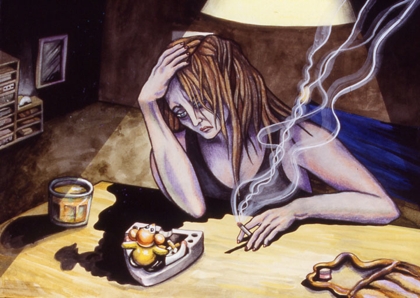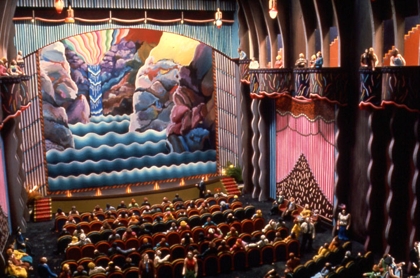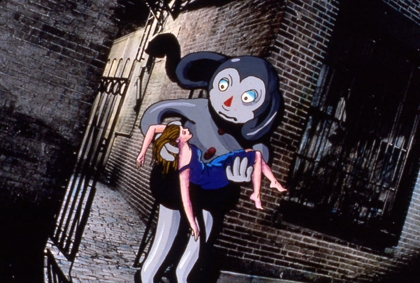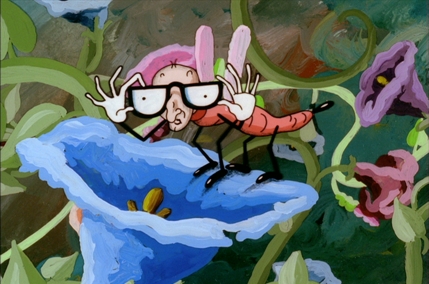Interview
Anima anime: Suzan Pitt’s wild psyches

Joy Street
From the Eraserhead-twinned Asparagus to her new Visitation, Suzan Pitt has animated the subconscious with the life of the cosmos. On the eve of a European tour, she talks to Laura Allsop
Suzan Pitt’s filmography is short but impressive. Since the 1970s the Los Angeles-based painter and animator has produced a handful of labour-intensive animated shorts that pulsate with life and colour. Thickly atmospheric and often uncanny or downright surreal, they celebrate the transcendent and often redemptive power of animation.
Not that she sees them as flights of fancy. “I wouldn’t call them ‘fantasies’, just because of the connotations of the word – something that isn’t grounded or based in our existence or in our psyches,” says Pitt, talking to me via Skype before a forthcoming European tour of screenings and masterclasses, starting at Birmingham’s Flatpack Festival on 18 March.
Pitt’s knack for tracing the vagaries of the psyche is epitomised by Asparagus (1978), perhaps her best-known work, which was famously – and aptly – paired with David Lynch’s Eraserhead on the late-70s midnight movie circuit. (The double-bill played for two years at New York’s Waverly Theatre and at the Nuart in Los Angeles.)
Mostly cel-animated, it’s as oneiric, engrossing and hypnotising as a deep daydream, seamlessly weaving together a succession of strange set-pieces around the presence of a female protagonist whose face we never see. She defecates two perfect asparaguses into a toilet bowl; investigates a doll-sized version of her own brightly-hued apartment, complete with a miniature of herself; and, now wearing a mask, heads out to a claymation theatre, into whose auditorium she unleashes magically flying shapes and objects from her bag. The final scenes show a mouth fellating an asparagus, which with each lift of the head changes form, from a waterfall to a cascade of multi-coloured pills to a wriggling, spiky creature.

Asparagus
“Often when you see dream sequences in feature films, they rely on some form of animation or special effects to try to represent the unreal quality of dreams,” says Pitt of her inspiration. “I don’t ever draw from dreams directly, but there’s a half-dream state I’m really fond of, almost like a cloud of images and impulses, which you can attain on early waking or before going to sleep, just between consciousness and unconsciousness.”
Asparagus, she says, follows Carl Jung’s idea of images being pregnant – “which means one image gives birth to another. That’s true if you consider how your mind thinks and wanders – there are no straight cuts.” Indeed, each image in Asparagus is folded into another with (other than in the claymation scenes) no straight cuts at all. For all its strangeness, the film follows its own internal, associative logic, giving it a sense of narrative progression.
What’s extraordinary about Pitt’s films, charging them with very particular moods, is her use of materials. Each cel is hand-painted, but she also uses a variety of media to reinforce characterisation. For example, in Joy Street (1995), which she made during a low point and which charts a woman’s fall into despair and re-awakening in a lush rainforest, the depressed female character is drawn in chalk. The effect is one of heaviness and of hazy, ragged edges, which render a character so freighted with anguish she hardly moves.
El Doctor (2006), a film about an alcoholic doctor privy to mind-boggling miracles during a brief reprieve from a heart attack, also uses unexpected materials. Fine sand from a beach in Oregon was animated over a light table to create a series of grainy, nightmarish images. A sequence in which the doctor rides a horse is composed of drawings on paper soaked in ink and subsequently crumpled, then filmed on an Oxberry animation stand without its glass platen to flatten the sheets, to give the sense of long-held desire or a fading memory.

Joy Street
In one psychedelic sequence in which the doctor is visited by a saint, the 35mm film itself was scratched and at points either bleached or painted onto with ink. And her most recent film, Visitation (2011), a dark, gothic piece in black and white, makes use of early cinema techniques such as mattes and multiple passes, as well as a hand-made sliding device beneath the lens, to emphasise the flitting, bat-like movements of her ghoulish figures. There’s a sense to these fleeting images not just of material tangibility, but also of the hand of the artist herself coming through.
“The way I move things, the materials I use and the context they’re in exhibit or enact my touch,” asserts Pitt. “Not in terms of ego, but insofar as there’s a creative hand in play, that I’m performing something just like in a puppet theatre, as opposed to something that’s so technically perfect it seems to come from some other place.”
The importance of the natural world is a theme that carries through almost all of Pitt’s work, be it the pulsating plants in Asparagus or the rainforest scene in Joy Street, inspired by the artist’s travels in Mexico and Central America.
“I have this theory,” she says, “that at the turn of the century or slightly before, when cinema, particularly the early cartoons, first appeared, that people vicariously experienced this sense of nature, of being surrounded by other living beings different from humans. Almost as though in the collective unconscious there was a realisation that we’d be at a loss without something to represent that. I think the creativity that forged early cinema satisfied that longing and was very hopeful.”

El Doctor
Joy Street is a particular example of the redemptive power of nature, relayed through animation. At the beginning, the female protagonist is seemingly locked in a concrete tower in a barren metropolis, peering disconsolately outside of grimy windows at a grey, urban vista. She then passes out following a disturbing scene in which, distraught, she presses her hands through cactus spikes. Meanwhile a toy mouse, a little tchotchke on her ashtray, comes to life and dances around her apartment to a jazzy version of ‘What a Wonderful World’.
Pitt (who recently appeared as one of the smokers portrayed in James Benning’s 20 Cigarettes) remembers the mouse on her own ashtray that inspired the sequence. “He was so pure and bright, and his colours were so beautiful, he gave me the positivity that emanates from cartoons, especially early cartoons,” she reminisces. The mouse breathes colour back into the grey apartment, and life back into the exhausted woman by taking her to the local park, which bursts alive with bright and unlikely flora and fauna.
Visitation too was inspired by natural phenomena. Pitt was living in a remote cabin in Michigan, reading Lovecraft when she first heard a pack of wolves howling. “I wasn’t afraid; I was just like, ‘Wow, that’s so primordial, so ancient, that longing, that crying in the wilderness’,” she says. The next day she set to work writing the poem which features in abridged form as the film’s voiceover.
Pitt’s work tends to evolve organically and her methodology changes from film to film, though she stresses that each is underpinned by a “meaty” conceptual idea. Often the films emerge from a series of paintings she makes, as with El Doctor, which she made while living in Mexico. Indeed, her first forays into animation, which began with a regular 8mm camera, came from painting.

Visitation
“A lot of the paintings I made looked like figures and scenes that were arrested in time, as though I had conjured them from somewhere and they could go somewhere too,” Pitt explains. Though she storyboards key events, she leaves the rest open. “So every day or every few days I have a new creative challenge, and I’m not just saying, ‘Today we do this, tomorrow we do that.’” Everything you see on screen, she reckons, consists of at least 12 different images per second, each entailing several hours work. Her films can take up to five years to make.
Between films, Pitt leads a varied creative life that involves teaching, travelling, painting and making music videos and cartoons. She’s held exhibitions at the Whitney Museum of Art in New York and the Stedelijk Museum in Amsterdam and was also, she tells me, the first person to use animation in opera, which she pioneered in Germany in the late 1970s and early 80s in productions of The Magic Flute and The Damnation of Faust. Her tour this month will also take her to Brussels, Ghent, Frankfurt, Amsterdam and London. She’s “toying” with an idea for a new film, and in the meantime is helping develop a project with The Jazz Passengers and Debbie Harry, who made the music for Joy Street.
“They’ve done this great collection of songs and built a narrative back and forth between the characters in the band, and the idea would be that I would make animation in between the sequences,” she says. “Together they make this hip, out-there jazz; it’s a cool thing they got going on.”
The Flatpack Festival presents ‘Exploring the Attic with Suzan Pitt’ at MAC on 18 March. The London International Animation Festival hosts ‘The Wonderfully Strange Animation of Suzan Pitt’ at The Horse Hospital on 31 March. Suzan Pitt’s homepage is at home.earthlink.net/~suzanpitt.
See also
Vision quest: Ian Francis investigates Robert Breer’s lifelong experiments with film (August 2011)
Quick cuts and slow change reviewed by Laura Allsop on the fate of UK experimental film in the wake of Arts Council funding cuts (June 2011)
Stars in his eyes: David Lynch talks to James Bell about his Dark Night of the Soul album (July 2009)
The thin black line: Harvey Deneroff on the innovations of Max Fleischer (June 1999)
